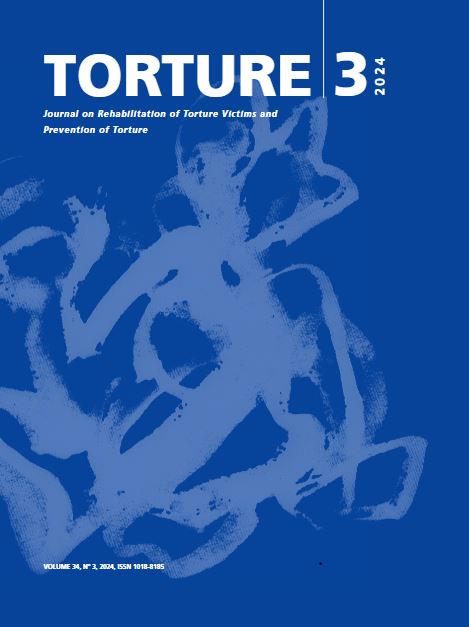Vol. 34 No. 3 (2024): Torture Journal: Journal on Rehabilitation of Torture Victims and Prevention of Torture

The issue opens with an editorial by Pau Perez-Sales and Sara Lopez-Martin, which examines the denial of abortion rights as a form of ill-treatment or torture. Drawing on international human rights jurisprudence, the authors outline how restrictive abortion laws can amount to cruel, inhuman, or degrading treatment, with severe physical and psychological consequences. The piece argues for the decriminalization of abortion and highlights the role of health professionals and legal practitioners in advocating for reproductive rights as part of broader anti-torture efforts.
Catarina Nahlén Bose and Ronak Tamdjidi contribute a systematic review on children who survive torture, focusing on the screening, documentation, and treatment of torture injuries in minors. This paper addresses a gap in existing literature, advocating for tailored approaches to ensure the psychological and physical well-being of child survivors. The authors emphasize the importance of child-specific protocols in torture rehabilitation centres, calling for stronger integration of pediatric care in torture assessment frameworks.
Nudd et al. present a research paper examining the health and legal implications of prison overcrowding. Their analysis highlights the link between overcrowded facilities and increased risks of ill-treatment, proposing legal and public health interventions to mitigate harm. The paper underscores the urgent need for systemic reforms to address prison conditions, recognizing the structural violence embedded within penal systems globally.
In another research contribution, Tinghög et al. explore the acceptability and preliminary effects of intensive trauma-focused PTSD treatment for refugees. Through a pilot study, the authors assess the outcomes of short-term interventions aimed at alleviating trauma symptoms. Early results suggest that such treatments can be effective in improving psychological well-being, though the study notes the importance of long-term follow-up to fully evaluate the impact of these interventions.
Anne Margrethe Sønneland contributes with an article which delves into the experiences of survivors rebuilding their lives after torture. Through narrative reconstruction, Sønneland explores the long-term social and emotional consequences of torture, shedding light on the resilience of survivors and the barriers they face in reclaiming their futures.
Berta Soley and Hugo Marboeuf discuss the implementation of the IRCT Global Standards on Rehabilitation of Torture Survivors through a piece that traces the path from the adoption of these standards to their practical application in rehabilitation centres worldwide, highlighting key lessons learned and strategies for strengthening the quality of care provided to survivors.
In the news section, Andrea Mølgaard reports on a historic legal victory holding a U.S. contractor accountable for acts of torture at Abu Ghraib prison. The article provides insight into the significance of this verdict for international justice and emphasizes the role of litigation in advancing accountability for torture.
The issue also features a letter to the editor from Anna Fierz, addressing the concerning rise in ocular injuries caused by less-lethal weapons in Switzerland. Fierz draws attention to the disproportionate use of such weapons in protest contexts, advocating for regulatory measures to safeguard civilians from unnecessary harm.
Finally, the issue closes with a call for papers on human rights violations in Israel and Occupied Palestine, encouraging submissions that reflect on the intersection of torture, conflict, and legal accountability in the region.

